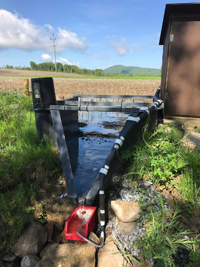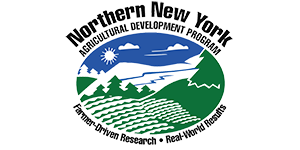
Chazy, N.Y.: October 8, 2019. Field-level research funded by the farmer-driven Northern New York Agricultural Development Program is responding to the need to better understand how tile drainage influences nutrient efficiency, water quality, crop production, and farm economics.
Results from the most recent data collection from tiles installed at the Lake Alice Wildlife Management Area in Chazy, N.Y., and on a working farm in Clinton County are adding to a database designed to quantify surface and underground movement of nutrients beyond field boundaries. The work has also begun identifying opportunities to develop best practices for nutrient conservation to support both crop production and environmental stewardship.
Project leader Laura Klaiber, Nutrient Management Researcher at W.H. Miner Agricultural Research Institute, Chazy, N.Y., explains, “Although tile drainage naturally exports some level of nutrients, until the Northern New York Agricultural Development Program established these research trials there had been very few in-depth year-round studies in this region designed to investigate how the use of tile drainage directly impacts runoff and nutrient cycling in agricultural fields.”
For some farms, the use of tile drainage significantly benefits crop yield, yield consistency, and crop quality; allows farmers to access fields sooner for spring planting and later in the fall for harvesting and cover crop planting; and can reduce soil erosion.

In the on-farm study, corn yields were 30 percent greater from the tile-drained field than an adjacent undrained field. Klaiber says the improved drainage may have created better conditions for root development and increased nitrogen mineralization rates in the soil, resulting in greater nitrogen availability for crop growth.
Overall, phosphorus losses across all trial plots were below thresholds for freshwater eutrophication.
However, Klaiber points out, “The data indicates that there is a pool of phosphorus at the soil surface which could pose a risk for higher losses during a year with more precipitation, particularly in the undrained field where there is a greater risk of surface runoff and erosion. These northern New York trials suggest that continued development, and use, of best management practices, such as cover cropping, would support efficient nutrient uptake and minimize nutrient loss, particularly in the spring season.”
 Separate projects funded by the Northern New York Agricultural Development Program are assisting farmers with whole farm nutrient balancing and refining precision manure and fertilizer application guidelines that help reduce the amount of phosphorus available for runoff, while supporting successful crop development and potential cost savings.
Separate projects funded by the Northern New York Agricultural Development Program are assisting farmers with whole farm nutrient balancing and refining precision manure and fertilizer application guidelines that help reduce the amount of phosphorus available for runoff, while supporting successful crop development and potential cost savings.
The complexities of weather interaction with different crops, cropping systems, field management, soil types, soil fertility, and topography are in the wings for next-step research and evaluation.
“As we all know, weather events can be highly variable and extreme, so multi-year data collection that increases our knowledge base is the foundation for developing the best management recommendations to positively impact nutrient use, farm economics, and environmental stewardship,” Klaiber points out.
The results of the Northern New York Agricultural Development Program-funded tile drainage projects are posted at https://nnyagdev.org/index.php/field-crops/drainage-management/, and have been presented at regional Crop Congresses; at watershed events in New York State; to the Vermont Agency of Agriculture, Food and Markets Tile Drainage Advisory Group; and to the House Agriculture and Forestry Commission, Montpelier, VT.
Funding for the Northern New York Agricultural Development Program is supported by the New York State Legislature and administered by the New York State Department of Agriculture and Markets.